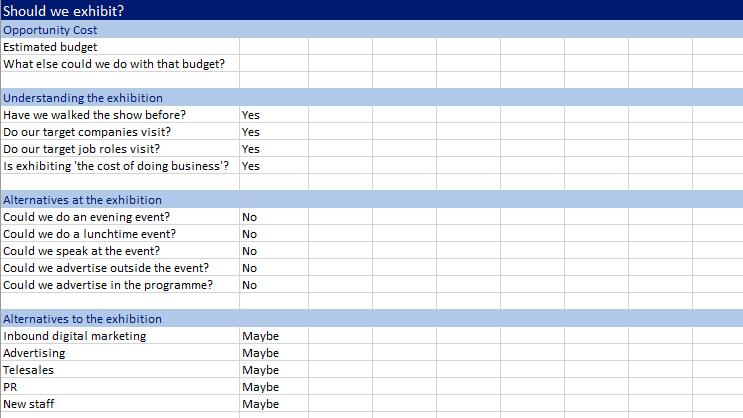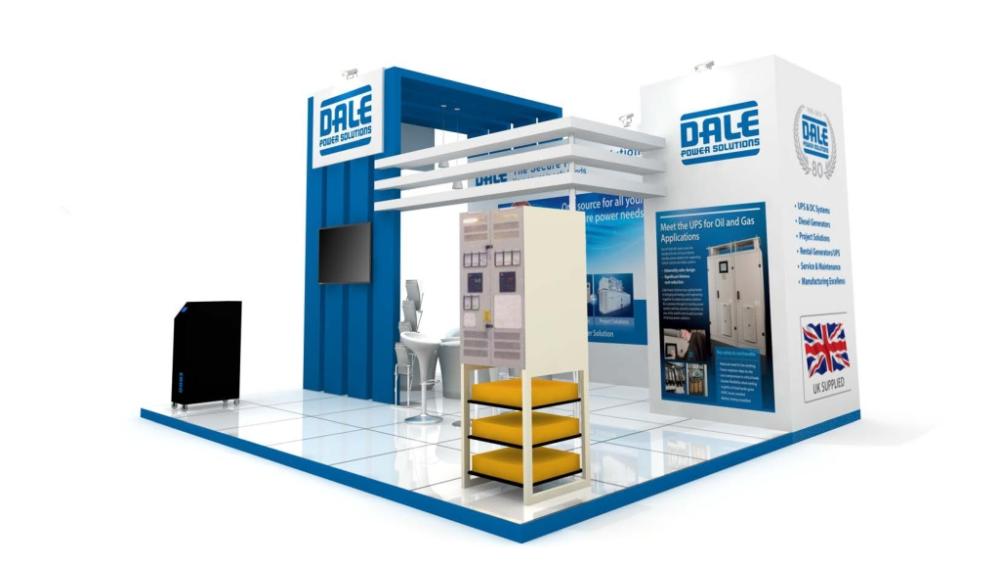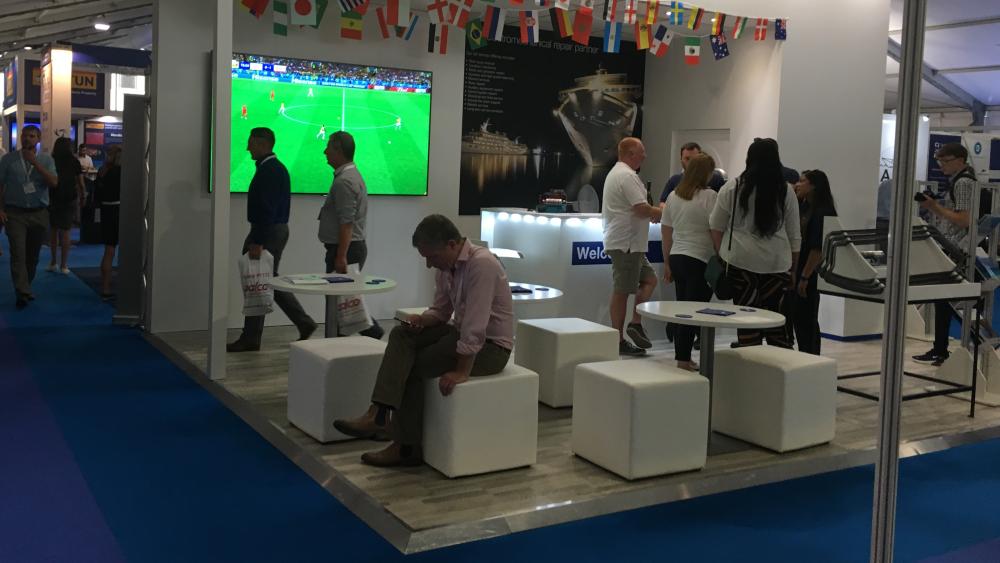Event management – exhibitions to webinars
Events benefit from strong organisation more than any other marketing activity. Effective event management stops them descending into the last-minute, logistical nightmares you often see. They can become the most rewarding marketing activity your business undertakes.
This guide and its associated downloads will help you develop successful events of any type:
- Taking a stand at an exhibition.
- Running a seminar, demonstration or open day at your own premises.
- Broadcasting a webinar.
Contents
This guide isn’t just about the obvious elements of event management: designing the stand and making sure the necessary brochures are ready. It’s also about the strategy that precedes an event:
- Which events should you attend or run?
- What type of event suits you and your audiences?
- What messages should you be promoting?
If you want events to be successful, ‘being there’ isn’t good enough.
Exhibitions
Advertising and exhibitions are the two biggest tickets in a marketing department’s budget. If you do them, you have to make sure they’ll work.
To go or not to go, that is the question
The target audience
Event management starts with your target audience. Your first question is whether your target audience will be at the event you’re considering. Do the right organisations visit? Do the right contacts in those organisations attend?
Be sceptical about the event organiser’s attendance data. Some organisers count people every time they go through the doors, even if they’ve been through six times before. As attendees, we tend to be less than honest about our details too. We give false email addresses and fudge our roles and seniority.
The only way to be sure about an event’s relevance is to walk the show and ask the opinions of your customers.
Staff and management engagement
Your stand staff won’t engage enthusiastically with attendees if they think the show is a waste of time. It’s vital that you know they’re behind your attendance. They have to understand why you’re there and what you want to achieve. You’re putting them in control of a large part of the annual marketing budget. They have to agree it’s worth doing.
Alternatives
You need to be certain that you can’t reach your target audience any other way. It’s perfectly valid for your event management process to decide that you shouldn’t do an event. Are there alternatives that could promote your message to your audience and, critically, lead to a face-to-face introduction to them?
The face-to-face element sets exhibitions apart from other marcoms activities. Before you propose attending an exhibition, you need to compare how quickly and expensively other lead generation techniques could get you to the meeting stage with your target audience.
Consider the benefits of exhibiting against inbound digital marketing, advertising, telesales, PR – or even new staff (exhibitions can cost more than salaries).
Also, consider the benefits of a stand against other activities you might run around the event. There are ways to use an exhibition even when you don’t exhibit there:
- Could you host a dinner on a night between exhibition days or after the end of the event?
- Could you host a lunch at or near the venue?
- Could you speak at the event?
- Could you take outdoor advertising (e.g. billboards) around the venue?
- Could you advertise in the event programme even if you’re not an exhibitor?
Assess your estimated budget for the event as an opportunity cost i.e. what else could you do with that money if you didn’t attend the exhibition?
Download FBA’s Event Management Template and use the ‘Deciding’ sheet to formalise your decision-making process.
The cost of doing business
Conventional wisdom suggests that you have to attend some shows even when there’s little chance of a positive ROI (Return-On-Investment). Reasons to attend include:
- It’s for brand awareness.
- People will think you’re in trouble if you don’t go.
- It gives you a chance to see and thank existing customers.
- It’s the ‘cost of doing business.’
None of these are great reasons for investing a huge some of money in an exhibition:
- When people cite ’brand awareness’ as the reason for an activity, it usually means they don’t know why they’re doing it and they can’t measure its success.
- If you’re worried about bad PR, you could publicise seminars, webinars and other activities you’re doing instead of the exhibition.
- Customer relations is a great reason for marketing activities but there are more cost-effective ways of improving relationships than an exhibition.
The truth is that you might attend exhibitions for a variety of reasons. You just have to be 100% satisfied that there your reasons are commercially valid.
Planning your attendance
Once you’ve decided to attend, you need to follow a formal event management process to make sure you’re pushing the right messages to the right people.
Use the ‘Deciding’ sheet in the Event Management Template to record the industry types you’re targeting, the people within those industries you’re going to reach, the products/services you’re promoting and the message you’re pushing.
Your message: what are you promoting?
Treat an exhibition like a mini-campaign. Follow an abbreviated version of the process on our Lead Generation page: target audience, goals and problems, value propositions, evidence, messaging, channels of communications.
If your attendance at the exhibition is part of an existing campaign, your messaging will already have been decided.
Your budget and ROI: what does success look like?
Use the ‘Costs’ sheet in the Event Management Template to measure ROI. It accommodates three measurements:
- If you sell from the stand, you can calculate ROI based on sales.
- If you use the exhibition for demand generation, you can calculate ROI based on the value of leads.
- If you use the event to explore the market in a looser way, you can calculate your cost per lead. This isn’t a true ROI but it gives you some measurement of success.
The same ‘Costs’ sheet records all of the direct (e.g. stand and accommodation) and indirect (e.g. planning and staff) event expenditure.
Stand Staff
One of your earliest decisions has to be who will man the stand? Although marketing staff organise an event, we’re rarely the best people to attend.
Attendees need one of two things:
- Sales information – they’re interested in purchasing. You need a salesperson to deal with them appropriately.
- Technical information – they need to understand how your product/service works. You need a technical expert who can answer their questions.
Make sure that your best people are available.
Partnerships
If you decide to promote a product/service that is supplied or supported by one of your business partners, could they support you? Drawing on business partners has several advantages.
- The partner may send a representative to provide specialist expertise.
- The partner’s representative can replace your staff, reducing your indirect costs for the event.
- The partner may provide marketing support in the form of collateral, demonstration facilities, videos, branded goods, etc.
- The partner may share the stand costs.
There’s no reason why more than one partner can’t support you, although you do need to be aware of overlaps and competition between them.
If a partner does join you on the stand, the event organiser may want to declare them as a co-exhibitor. This has the advantage of getting the partner listed in the programme.
Shell-scheme or space-only?
A shell-scheme stand has carpets and panelled walls. A space-only stand has nothing; the exhibitor builds everything themselves.
The advantage of space-only is that you can build a customised stand that looks unique. The disadvantage is that it takes longer to design and costs more.
Hanging custom vinyls on the walls of a shell-scheme stand is an effective compromise between the two. Wall panels are a standard size around the world so it’s relatively easy to design vinyls that entirely cover the plain walls and make the stand look remarkably personalised.
Custom vinyls are especially useful for overseas shows. You can check the vinyls at home before they’re sent to the show with the rest of the equipment. If you have a space-only stand built on-site, you can’t check it until the eve of the show.
Which facilities do you want from the organiser?
Event organisers always want you to order extras on top of your stand space. Strike a balance between convenience and quality.
- You always need power sockets and you need to make sure they’re in the right place.
- It’s usually more convenient to use the organiser’s TV, especially if you want it mounted on a wall. You need to make sure it can run a presentation from a USB stick.
- A stand doesn’t need special lighting unless it’s especially small or tucked away in a corner. Walking an earlier show will highlight the hall’s characteristics.
- Most events stop you providing food and drink from your stand. You can usually get away with coffee and water. If you want to provide alcohol, you usually have to buy (some of) it from the organisers.
- You have little choice but to use the organiser’s tables, chairs, display cases and other furniture but it’s always tatty and disappointing. A great work-around is to take your own colour coordinated tablecloths and chair covers. If they’re branded, your shell-scheme stand starts to look like the best space-only stands.
- We’ve never been impressed by the information we get from data loggers. Even if the attendee has provided accurate information (that’s a big ‘if’), you still have to record the substance of your conversation with them. That gives you their contact details in one place and the lead details in another. Harvesting business cards is still the best way to get basic contact information.
- Since the advent of 4G, creating a personal hotspot through a mobile phone has provided reliable data access on the stand. It’s rare that you need the organiser’s Internet access. Only order it if you want to run web-based video or applications during the event.
Moving your stuff: the indispensable flight case
If you’re going to make events a key part of your marcoms plan, one of the best investments you can make is a flight case.
- It’s large and tough so it holds all your exhibition equipment.
- You can put a branded table-cloth over it so it doubles as a display stand during the event.
- At the end of the event you can pack up quickly because you don’t have to wait for the organisers to bring packing cases back from storage.
Associated events
Most exhibitions have associated events that can boost the value of your attendance. They cost more money but they raise you above the level of mere exhibitors and focus attention on you.
The best associated events are booked early. You need to contact the organiser rather than wait for them to contact you.
Manage associated events with the ‘Extra Events’ sheet in the Event Management Template.
- The event dinner offers great networking opportunities because senior managers who didn’t man a stand during the day might still attend the dinner at night.
- An awards ceremony requires a carefully-considered submission but it has all the benefits of the event dinner plus the publicity value of winning an award.
- Most exhibitions offer delegates best-practice sessions in break-out areas. Speaking at these adds authority to your brand. Some attendees are more comfortable listening to a presentation than approaching your stand for a one-to-one talk.
- Some exhibitions go beyond best-practice sessions by hosting a round-table panel to answer questions from the floor. Being on the panel gives you even more kudos than speaking but you need a quick-witted speaker.
The event programme
When you’re asked to submit your text for the event programme, it’s tempting to send the standard company description. You need to be 100% certain this is relevant to the attendees.
- Most importantly, does your company description give them a reason to come to your stand?
- Will they understand what you say?
- Will they already know your company name?
A good description makes an advert in the programme unnecessary. Organised attendees study the programme (or the web version) to see who’s exhibiting. A compelling entry draws people to you.
Stand design
Unless you adopt a very basic theme, you have to use a design agency to create the look of your stand. You need to consider:
- Sightlines: you need your most important messages on the first wall attendees see.
- Visibility: you need contact details and key messages high enough so they’re not obscured by furniture, TVs, demo equipment, people, etc.
- Approachability: your demo stands and furniture should be convenient and accessible but they mustn’t become a barrier that stops people entering your space.
- Environment: there are occasions when you can make use of the other stands or facilities near you, even if it’s just a “get a coffee without queuing” message.
- Acoustics: some exhibitions are noisy. You need to subtitle videos in case attendees can’t hear the soundtrack. Any furniture that might obstruct a comfortable face-to-face conversation has to be moved.
Other items: the Event Management Template
Other essential planning items such as brochures, demo products, giveaways and dress code are covered in ‘Stand’ sheet of the Event Management Template.
Before the event
Publicity is a high priority in the run-up to the event. Rather than just say “we’ll be on stand 234, come and see us”, you should craft your messages to promote a specific reason to come: a launch, a demonstration at a specific time or even a feature that people might have forgotten. Then you can produce:
- A6 cards your customer-facing staff can hand out.
- Email footers for everyone’s regular emails.
- Social media posts for your most popular platforms.
- A dedicated email series.
In the background, the marketing department also needs to produce the materials your stand staff will need:
- A presentation for the specific event.
- Collateral for the event’s specific messages.
- An updated content set for your sales enablement tool so all the information staff need is at their fingertips. iPresent is one such tool.
At the event
Your stand manager is responsible for the event running smoothly. It’s the manager’s job to make sure stand staff arrive on time, adhere to the dress code, remain approachable to attendees and project the professional image you want future customers to see.
After the event
CRM
If they can’t do it during the event, your stand staff must put lead details into your CRM system within a week of the event. You need to work in conjunction with your sales managers to ensure the information is comprehensive: full contact details, the nature of the enquiry, a potential value, a potential timescale and a potential likelihood.
Follow-up
The marketing department needs to setup an automation to send each lead a portfolio of information relevant to their enquiry. The end of an exhibition is the start of a nurturing process.
The problem with events is that they represent ‘time out’ from your staff’s everyday life. As soon as the event’s over they go back to normal work and neglect all but the most positive leads from the event. It’s marketing’s job to make sure every lead is exploited.
Post-mortem
You should hold a post-mortem within two weeks of the end of an event. The purpose is to review whether it hit its targets, identify ways to improve the way you do exhibitions and decide if you want to attend again. Exhibitors offer discounts for early bookings.
Seminars, demonstrations & open days
Why run your own event?
The table below summarises some of the pros and cons of running your own event as opposed to attending an exhibition. They can be summarised simply:
An internal event costs less, gives you more time with the attendees, lets you do and show what you like, frees you from calendar constraints and takes staff away from their jobs for less time
BUT
You’ll have zero attendees unless you work incredibly hard to get them
If your marketing capabilities are strong, it’s practical to attract attendees to your own event.
If you’re not so confident in your marketing and promotional abilities, you’re best-advised to exploit the attendance an event organiser can generate.
| Exhibition | Internal Event | |
| Budget | Higher | Lower |
| Focus | Lower, attendees spend a little time with you | Higher, attendees dedicate all of their attendance to you |
| Draw | Higher, attendees see several suppliers in one visit | Lower, attendees only see you |
| Space | Less, you’re restricted to your stand | More, you have your whole office |
| New customers | Attractive, the event is better know than you | Weak, your brand might be unknown |
| Existing customers | Constrained, limited space and facilities | Free, you have total freedom |
| Scheduling | Restricted, the organiser sets the date | Free, you set the date |
| Planning | Even, both are time-consuming | Even, both are time-consuming |
| Logistics | Complex, everything needs transport | Simpler, everything stays onsite. |
| Flexibility | Limited for displays and demonstrations | Flexible for displays and demonstrations |
Organising your own event
Most guidelines for organising your own events are similar to attending an exhibition. You still need to be clear about your budget, messaging and goals. You still need to have appropriate collateral prepared and partners on-board. You still need to decide if you’re organising associated events like a dinner and overnight accommodation. You still need an effective follow-up after the event.
But there are some differences that don’t apply to an external exhibition.
Seminars
Any seminar will want to cover a number of topics. If you want to keep the organisation simple, you’ll run them sequentially in one place with your attendees sitting theatre-style in your biggest meeting area.
If you want to encourage engagement and activity (and you do), you’ll break the attendees into smaller groups and move them between rooms with a different subject being run in each room. Smaller groups are more interactive and the movement keeps your attendees engaged.
If you have more subjects that time allows, you can ask attendees which subjects are most relevant to them. Your scheduling job becomes more complex but the end result is a better seminar for your attendees.
You also need to check your dates don’t conflict with other events or holidays that’ll affect your target audience.
Demonstrations and Open Days
There are some golden rules to follow with demonstrations and open days. You must make sure:
- The demonstration works.
- The demonstrators are available on the day, preferably with a stand-in in case of emergencies.
- The necessary equipment is available on the day and staff who normally use it know it’s unavailable that day.
- You have rehearsed the demonstrations, any related presentations and your hospitality routines (meet and greet, coffees, meals, etc.).
- Your demonstrators can be heard. Hire a PA system with lapel mics if necessary.
- Your attendees will understand what you demonstrate.
- The demonstration shows the advantages of your product/service, not just activity.
- The demonstration is as interactive as possible.
- The appropriate safety equipment is available and health and safety briefings are delivered.
- All staff are briefed that visitors will be in the building so they should dress and behave appropriately.
- Staff know certain rooms and resources will be unavailable that day.
- Demonstrations are photographed and recorded so they can be publicised through social media and distributed to contacts who couldn’t attend.
- You take feedback about the day and your products/services from attendees.
Generating Attendance
The processes you follow to generate attendees for your own events are the same as for exhibitions. It’s the priority that differs. Failure means no attendees.
Your publicity techniques can match those we listed earlier but you need to start earlier, at least 8 weeks before the event.
You can track attendance using the ‘Extra Events’ sheet in our Event Management Template spreadsheet or you can use 3rd party services such as Eventbrite or Zoho Backstage. The advantage of 3rd party tools is that they integrate invitations, agendas, feedback and many other facilities into one interface.
Break-Outs
One advantage of an in-house seminar is that most of your staff – including senior management – are in the same building.
If a (prospective) customer needs to be reassured or encouraged, organise a break-out session during the day for a one-to-one.

Event management is part of a sales process. Bring key people to break-out meetings at on-site events.
Webinars
Webinars were a well-established and popular event type even before the COVID-19 pandemic made face-to-face events impossible.
Webinars are often a standard part of a marketing campaign because they’re easier and less expensive than seminars. If, for example, you produce a presentation to support a campaign, why not build a webinar from it? A webinar presentation is very similar to a face-to-face presentation; you’re halfway there.
Because they get easier as you do more of them, you should try to build a schedule for regular webinars. Although they’re events, you should treat them like social media posts – a calendar imposes discipline and reaps dividends.
| Seminar | Webinar | |
| Budget | Higher | Lower |
| Focus | Higher, you have attendees attention | Lower, you can be in attendees’ background |
| Draw | Higher, attendees see tangible people, products/services | Lower, attendees see on-screen representations |
| Presenters | In your office, they lose time travelling to the event | Local, they dial in from anywhere in the world |
| Time required | More, attendees must dedicate half or full day | Less, no travelling so easier to ‘attend’ |
| Scheduling | Even, you set the date | Even, you set the date |
| Planning | High, time-consuming | Low, easier, especially after the first |
| Logistics | Complex, organising rooms, people, demos | Simpler, just master webinar software |
| Flexibility | Even, you set the agenda | Even, you set the agenda |
Our golden rules for running successful webinars are:
- The host and presenters must understand how they’re meant to use the software. It’s best if marketing staff host the webinars and leave the presenters to do little more than talk. Potential packages include GoToWebinar, Zoom and Zoho Meeting.
- Buy high-quality microphones to improve audio quality. Laptop microphones are terrible. A high-quality desktop microphone such as a Jabra or Yeti is good. A headset microphone such as a Plantronics Blackwire is best.
- You must produce a high-quality presentation with a script for your presenters to follow. If they’re inexperienced, it should even include {next slide} prompts. Video doesn’t always render well in a webinar presentation so you should avoid it.
- The presenters must rehearse the webinar until they’re comfortable delivering it.
- If you’re lucky enough to have more than one presenter, encourage back and forth interplay between them.
- A marketing person is often best-placed to act as the webinar host and moderator. It would be our job to introduce the presenters, talk about house-keeping and even move the slides along.
- Prepare some canned questions to kick start the Q&A session at the end.
- Record the webinar for reuse as stock content. You can send it to interested parties who couldn’t attend and promote it through social media.
- You can use optional refinements to make your webinar stand out from the rest. For example, have a series of slides to act as a rolling introduction while delegates wait for the webinar to start or superimpose video of the presenter onto the presentation slides.
Generating attendance.
There are two subtle differences about generating attendance for webinars.
- Firstly, you can run webinars even if there’s no audience. We’ve done it. It leaves you with recorded collateral that you can use in later marketing campaigns. You can also add it to any knowledgebase or academy programme you develop.
- Secondly, if you develop a webinar calendar you can build an audience of regulars who can be relied on to attend.









